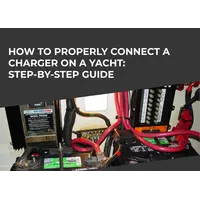Are you unhappy with the efficiency of your solar panels already installed on your yacht? Or are you just looking to power your boat with cheap solar power in the most optimal way? Then this article is for you. After completing countless cruising and long-distance passages, we share some tips to help you improve the efficiency of your mini solar station on your yacht.
Also, based on the extensive experience of autonomous sailing, at our marketplace we have selected for you a diverse range of solar panels and accessories for them (batteries, controllers, inverters, etc.). This choice gives you the opportunity to create an onboard power supply system that would exactly match the capabilities of the vessel, your preferences as a skipper, as well as the needs of the crew, including comfort.
Choosing the Right Solar Panels
Solar panels are designed to convert the sun's energy into electrical energy. They are also called solar panels or solar modules. A solar panel is a device consisting of photocells that convert one type of energy into another.
Photocells are semiconductor wafers that directly convert solar radiation into electrical current. Photocells are connected to each other in parallel or serial electrical circuits, which together work as a single source of electric current.
Photovoltaic cells are made primarily of silicon. It is solar batteries with silicon photocells that are produced on an industrial scale. Less commonly used are cadmium, tellurium, copper selenides, and amorphous silicon. An even smaller percentage are thin-film solar cells.
An industrial solar panel consists of multiple laminated photovoltaic cells bonded together and mounted on a flexible or rigid substrate. The efficiency of such a battery depends largely on the purity of the silicon and the orientation of its crystals.
Industrial solar panels are classified according to their design features and the type of working photovoltaic layer.
Types of Solar Panels
Based on the type of construction, solar panels are divided into flexible and rigid panels.
Flexible thin-film panels are gradually occupying an increasingly large niche in the market due to their mounting versatility, because they can be installed on most surfaces with a variety of architectural forms.
But rigid structures are more efficient. Therefore, they are widely used on yachts and catamarans with sufficient area to accommodate these modules, including the addition of flexible panels where possible.
Based on the type of working photovoltaic layer, solar batteries are divided into silicon ones, which are of interest specifically to yacht owners, and more rare types, in making of which other types of organic elements and polymers are used. Although some other types of panels have higher efficiency, they are not widely used due to their high cost.
Silicon solar cells, in turn, are divided into monocrystalline, polycrystalline and amorphous (or flexible).
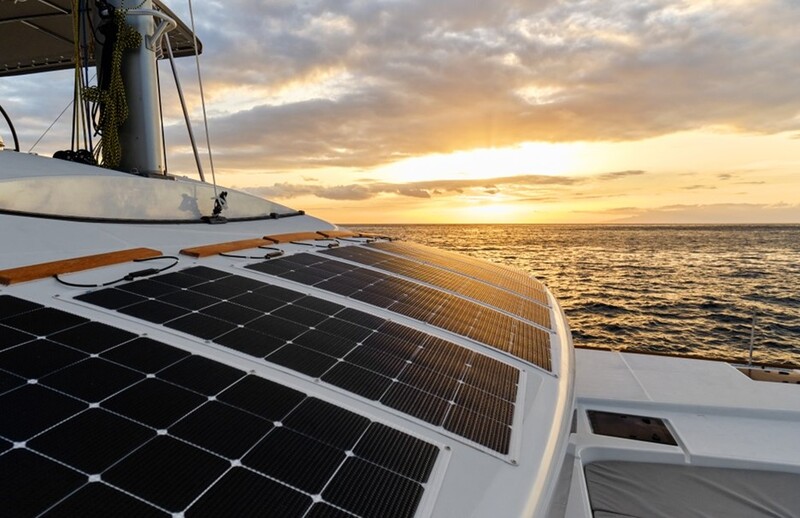
Monocrystalline solar panels are an advanced technology in the field of photovoltaic systems. These panels are made from high-quality single die grown silicon. Thanks to this, they have a high conversion rate of solar energy into electricity, which helps to obtain maximum energy production efficiency in limited areas. Such panels are often used in solar installations where not only power is important, but also aesthetics, as they have a uniform dark surface without visible partitions.
The production of monocrystalline solar panels involves a process in which a silicon crystal is slowly formed from molten silicon, resulting in high purity and a uniform structure of the material. This technique produces panels that have fewer defects in the crystal lattice, which directly affects their performance and durability.
Modern technologies such as PERC (Passivated Emitter Rear Cell) improve performance by allowing the back of the cell to capture reflected light and convert it into energy, increasing overall electrical output. In the topRik marketplace you can buy PERC solar panels manufactured by Ultimatron France.
Due to their high efficiency and reliability, monocrystalline panels are particularly effective in regions with high levels of solar insolation, however, due to their ability to generate energy even at low light levels, they are also suitable for use in regions with cloudier climates.
With proper operation, the service life of monocrystalline solar cells is at least 30 years.
Monocrystalline silicon solar cells are sensitive to contamination. Dust scatters light, so the efficiency of solar panels covered with it sharply decreases.
Due to the need for direct sunlight, monocrystalline solar panels are installed mainly in open areas or at heights. The closer the area is to the equator and the more sunny days it has, the more preferable it is to install this particular type of photovoltaic elements.
Polycrystalline solar panels (multi-Si) have a blue color that is uneven in intensity due to the diversified orientation of the crystals. The purity of silicon used in their production is slightly lower than that of monocrystalline analogues.
Multidirectional crystals provide high efficiency in diffused light - 12-18%. It is lower than in unidirectional crystals, but in cloudy weather conditions such panels are more effective.
The heterogeneity of the material also leads to a reduction in the cost of silicon production. The purified metal for polycrystalline solar panels is poured into molds without any special tricks. In production, special techniques are used to form crystals, but their directionality is not controlled. After cooling, the silicon is cut into layers and processed according to a special algorithm.
This production method has a lower cost than monocrystalline panels and makes polycrystalline panels more affordable than other types.
Polycrystalline solar cells do not require constant orientation towards the sun. They are suitable for applications where space allows for the deployment of larger solar panel systems, as well as for use in sailing regions with variable climatic conditions.
The service life of polycrystalline panels is up to 25 years.
Amorphous (flexible) solar panels are a relatively recent innovation in the renewable energy market. They combine mobility, ease of installation and sufficient efficiency. These solar panel models are especially popular where traditional rigid panels are not practical due to their weight or installation restrictions, for example, on roofs with limited load-bearing capacity or on uneven surfaces, which is typical for most small yachts and boats.
Flexible solar panels are made of highly efficient materials: amorphous silicon, CIGS (copper, indium, gallium, selenium) and other lightweight composites. These panels can bend to a specific angle, making them ideal for use on a variety of surfaces including campervans, yachts and temporary installations.
In addition, the battery has other advantages: waterproof design, no glass parts, light weight, and also the small thickness of the panel does not create additional wind resistance.
The mechanism for producing solar panels from amorphous silicon is fundamentally different from the production of crystalline photovoltaic cells. Here, not pure flint is used, but its hydride, the hot vapors of which are deposited on the substrate.
As a result of this technology, classical crystals are not formed and production costs are sharply reduced.
The physicochemical structure of amorphous silicon allows maximum absorption of photons of weak scattered light to generate electricity. Therefore, such panels are convenient for use in sailing regions with insufficient solar radiation.
The efficiency of batteries based on amorphous silicon does not decrease even at high temperatures, which makes it possible to use them in the tropics.
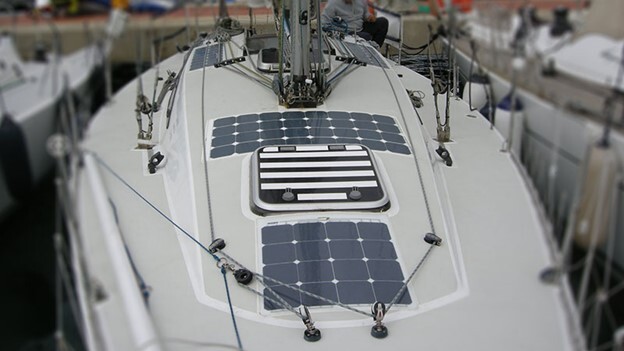
Efficiency of Different Types of Panels
Monocrystalline solar panels are superior to polycrystalline and thin film panels in several ways. Their main advantage is their high efficiency, which can reach 25%, while for polycrystalline panels the efficiency is usually 15-19%, and for thin-film (flexible, amorphous) panels - 10-13%. This explains why monocrystalline panels are often chosen for installation where it is important to make the most of limited space, including on ships.
Monocrystalline solar cells have the highest price among all silicon wafers, since they are produced using the purest silicon. Hence the highest efficiency.
The advantages of monocrystalline silicon batteries include:
- high efficiency with a value of 17-25%;
- compactness – smaller area of equipment placement per unit of power, in comparison with polycrystalline and amorphous silicon panels;
The disadvantages of such batteries are their relatively high cost and long payback period.
The disadvantages of polycrystalline panels are reduced efficiency with a value of 12-18% and relative bulkiness. Their installation requires more space per unit of power compared to monocrystalline analogues.
Solar cells with multidirectional crystals have significantly more advantages:
- high efficiency in diffuse light conditions;
- possibility of permanent installation on the flybridge roof;
- lower cost compared to monocrystalline panels;
- duration of operation - the drop in efficiency after 20 years of operation is only 15-20%.
Polycrystalline solar panels are gaining an increasing market share among other silicon batteries. This is ensured by wide potential opportunities for reducing the cost of their production. The efficiency of such panels also increases every year, rapidly approaching 20% for mass-produced products.
The advantage of amorphous (flexible) panels is their low cost compared to solar panels with a rigid structure. But besides this, amorphous solar cells have additional advantages that attract the attention of sailors.
At the moment, there are already three generations of amorphous silicon panels, each of which significantly increases efficiency. If the first photovoltaic modules had an efficiency of 4-5%, now second-generation models with an efficiency of 8-9% are widely sold on the market.
The latest amorphous panels have an efficiency of up to 12%.
Due to the peculiarities of the production technology, it is possible to create a layer of silicon on both a rigid and flexible substrate. Because of this, amorphous silicon modules are actively used in flexible thin-film solar modules. But options with an elastic backing are much more expensive.
In a standard flexible panel, multiple layers protect the solar cell. The first is EVA, a common industrial plastic polymer that is used to encapsulate solar cells in the thermal lamination process . EVA insulates the cell from any contact with liquids, powders, vapors or gases.
The outer layer is made from PET, another plastic polymer widely used in all areas of industrial production. In flexible solar panels, it is used as an outer coating because it has good mechanical strength, ductility during production and remains flexible after application.
However, PET has low thermal resistance and is not recommended for use in very hot environments. A good marine flexible solar panel should have an ETFE coating. ETFE - ethylene tetrafluoroethylene - fluorine-based plastic. It easily withstands high temperatures and transmits light well. Its transparency to sunlight is 95%. Flexible solar panels using ETFE are anti-reflective, highly corrosion resistant and durable. Compared to PET, they are more efficient and economical.
ETFE is not only durable and UV-friendly, but it is also smart. Due to the chemical properties of the molecules, the fluoropolymer is self-cleaning and maintains transparency throughout its entire life cycle. Unlike PET, ETFE has a high flame retardant rating, making it suitable for hot, dry climates.
The ETFE panel costs 60% more than the PET equivalent for the same power output. However, the PET option requires extra care and attention if you want to extend the life of your solar panels to the maximum possible.
The advantages of amorphous solar panels include:
- versatility - the ability to manufacture flexible and thin panels, installing batteries on any architectural form;
- high efficiency in diffused light;
- stable operation at high temperatures;
- simplicity and reliability of design - such panels practically do not break;
- maintaining performance in difficult conditions - less drop in performance when the surface is dusty than with crystalline analogues;
The service life of such photovoltaic cells, starting from the second generation, is 20-25 years with a power drop of 15-20%. The only disadvantages of amorphous silicon panels include the need for larger areas to accommodate equipment of the required power.
Optimal Placement of Panels
If you've read the characteristics, advantages, and disadvantages of the main types of solar panels for boats, then you already know that the installation method and location for most modules is critical to achieving maximum efficiency. Correct installation should ensure such a position that the sun's rays illuminate the maximum area of the panels for the maximum daily time.
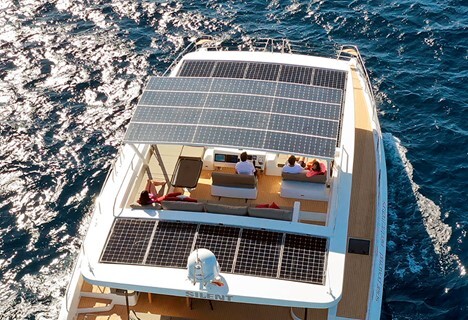
Installation on Deck and Cabin Roof
Choosing an installation location is one of the difficult tasks, especially considering the limited areas for mounting panels on yachts. When choosing where to place the panels, consider the available space on the deck or roof of your boat. Aim for unobstructed areas with direct sunlight exposure. Avoid shading from antennas, masts or other equipment that may impair the performance of the panels. Also, ensure sufficient air flow around the panels to prevent overheating.
If the yacht has a flybridge, then you can use its roof and canopies over the cockpit and stern. Installing panels on cabin roof is more difficult, especially if the yacht is sailing type.
Portable rigid modules can be installed on the deck by adjusting their angle of inclination.
Tilt Angle and Orientation of Panels
You can greatly improve the efficiency of your solar panels by adjusting their angle to maximize sunlight exposure. This is not an easy task, especially since a yacht does not stand in the same place like a house.
Therefore, it is impossible to apply to ships the principle of calculating the adjustment of the angle of inclination of solar panels, which is applied to stationary objects. But the basic provisions of this principle should be taken into account. For example, the maximum elevation angle for your favorite sailing region, that is, the maximum height of the Sun in the sky at a certain time of year, maximum solar activity and other parameters. There are special online calculators that make the calculation easier.
Movable and Rotating Mounts
Determining the ideal panel mounting and placement option is critical to maximizing solar exposure and optimizing energy production. A variety of mounting options are available, including fixed mounts, angled mounts and flexible mounts.
Fixed mounts are the most common and simplest option, but tilt mounts allow you to adjust the angle of the panels to optimize solar energy capture.
Possible installation of solar panels:
- onto a fixed structure at an optimal angle;
- on a biaxial tracker (a rotating platform that can rotate behind the sun in two planes);
- to a single-axis tracker (the platform can change only one axis, most often the one responsible for tilt).
Flexible mounts are ideal for curved surfaces or irregularly shaped boats.
Keeping Panels Clean
Regular maintenance is essential to ensure the longevity and optimal performance of your marine solar panel system. Here are some key maintenance tasks to keep in mind.
- Regularly clean your solar panels to remove dirt, dust and debris that can reduce their efficiency. Use a soft brush or sponge with mild soap and water to gently scrub the surface. Avoid using abrasives or harsh chemicals that may damage the panels.
- Carry out regular inspections of panels, fixtures and wiring connections to look for any signs of damage, loose connections or corrosion. Address any problems immediately to prevent further injury or power outages.
Ensure that mounting brackets, connectors and wiring connections are properly sealed and watertight. This prevents water penetration and protects the system from corrosion and electrical problems.
Equipment Update and Modernization
If you're looking to improve the performance of your solar panels, upgrading your yacht's installed electrical system to accommodate the panels is a must.
Using MPPT Controllers
The charge controller in a yacht's electrical system has a key impact on the efficiency of the solar panels. The energy received from them is distributed precisely using the controller. The regulator also maintains the desired output voltage to avoid discharging or, conversely, overcharging the battery. And this extends the service life of the entire solar power system.
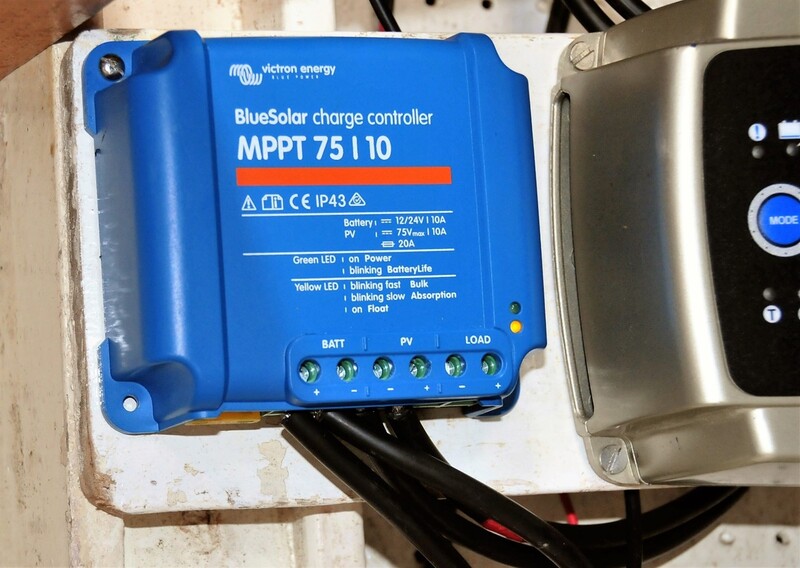
Maximum Power Point Tracking technology (MPPT) is an algorithmic approach used in inverters to optimize the process of extracting the maximum possible power from solar panels. The operating principle of MPPT is based on continuously monitoring and adapting to the current maximum power point (MPP) of the PV module, which changes depending on various operating conditions such as illuminance and temperature.
PWM (Pulse Width Modulation) is an older charge control technology that regulates the voltage and current supplied to the battery by turning an electrical circuit on and off at a specific frequency. This method effectively prevents batteries from overcharging and extends their life, but does not optimize the power extracted from solar panels.
This means that an MPPT controller can extract more power from the same solar panels than a PWM controller, especially in low light or high temperature conditions where the efficiency of the panels decreases, which is very important in off-grid sailing conditions.
Battery Update
Selecting and replacing old batteries with modern ones with greater capacity and efficiency will significantly increase the efficiency of solar panels.
Deep cycle batteries play a key role in solar energy systems and uninterruptible power supplies (UPS), providing reliable storage and delivery of electricity when needed. Our range of batteries includes a variety of battery types: AGM, Gel, LiFePo4, which are suitable for a wide range of applications, including solar energy systems, as well as other applications requiring high quality and reliable power sources.
- AGM batteries (lead-acid with absorbed electrolyte) are characterized by high performance and long service life. They are ideal for use in solar systems due to their deep discharge capability and fast recharge.
- Gel batteries provide even greater safety and reliability due to the use of a gel electrolyte, making them an ideal choice for use in difficult marine conditions.
- LiFePo4 (lithium iron phosphate) batteries are an advanced technology that provides high energy capacity, long service life and increased safety. These batteries are ideal for systems that require a reliable power source with minimal maintenance.
Energy Monitoring and Management
In order for the efficiency of the electrical system on a yacht to be consistently high, the energy received and distributed must be constantly monitored, as well as the sources of its supply must be controlled. Solar panels are one such source and need constant monitoring.
Installation of Monitoring Systems
topRik marketplace offers a wide range of equipment and devices for monitoring the performance of solar panels - from a simple battery monitor to more complex systems.
Although a modern battery monitor is an intelligent monitoring device that, after entering the necessary data, learns itself and then ensures that the set parameters are not violated. In the event of such a violation, the device sounds an audible signal or displays a programmed alarm on the screen.
Depending on the complexity of the electrical system on board, you can integrate more extensive battery monitoring systems into it, which include additional shunts and sensors that allow you to manage energy, including remotely. Being at a considerable distance from your yacht, using applications installed on your smartphone, you can monitor the progress of the power supply of your yacht, which is anchored at sea or in the port. And not just observe, but, if necessary, turn on, switch or turn off batteries, including solar ones.
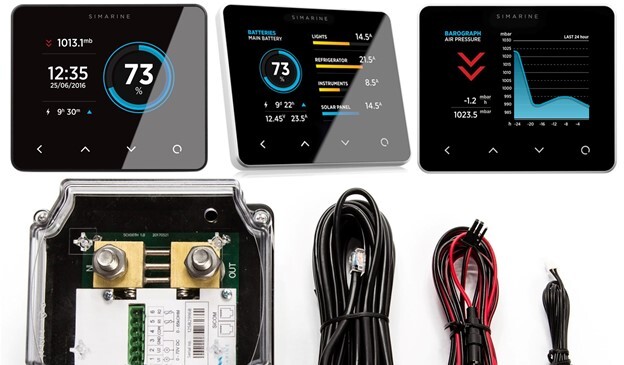
Energy Optimization
To effectively use accumulated energy, use timers and programmable controllers wherever possible. Avoid wasting energy just because you forgot to turn off the switch – delegate the precise timing to the controller with due maintenance when needed.
Sea Route Optimization
On a yacht equipped with alternative power sources, it is very important to plan the route correctly. Yachtsmen, for example, during long passages take into account weather conditions, in particular the predominance of wind direction. And for a yacht that uses solar panels as one of its power sources, you should consider a route to provide the panels with maximum time spent in direct sunlight.
Route Planning while Taking into Account Solar Activity
You will have to carefully study the weather conditions of the route, also from the point of view of solar activity and daylight hours.
Data on weather conditions and solar cycles in various regions are available on specialized websites. For more precise adjustments, you can use GRIB files (GRIdded Binary) - compressed weather data format. It is used by many services, the data itself is provided by various government organizations. Any weather services can freely use this data to generate forecasts based on their own algorithms.
If you walk in a coastal area where there is cellular communication, then you can simply download GRIB files via the mobile Internet. On the high seas you will have to use satellite communications.
Choosing the Time to Stay at Anchor
You can charge solar panels both on the go and while docked. Therefore, choose a place and time for docking so that in places with maximum solar activity your panels charge for the maximum time. It even makes sense to plan ahead having a certain weather forecast in mind. After you spend some time with your particular model of solar panels and get used to their charging speed, you’ll be able to predict how long it takes until full charge – it’s nothing but trial and error.




